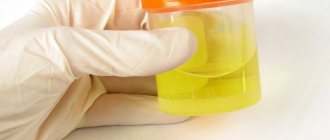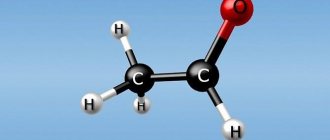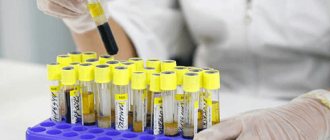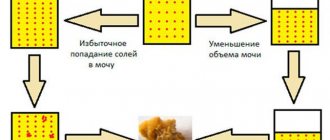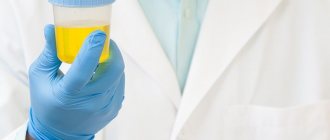What the study shows
Doctors primarily associate an excess of catecholamines in the urine with the presence of tumors. Quite often, an excess of hormones of this group in the urine is caused by high blood pressure or associated with the onset of myocardial infarction.
All these conditions require the mobilization of the body's defenses, which is necessarily accompanied by the release of a large volume of catecholamines into the blood. An excess of these substances in the bloodstream is accompanied by an increase in their concentration in the urine.
In addition to abnormalities in the functioning of the cardiovascular system, problems with the thyroid gland and liver are identified.
A sharp increase in adrenaline and norepinephrine in urine occurs with serious head injuries. A large number of adrenal hormones in biological fluids may be evidence of drinking a large dose of alcohol or coffee.
With an increased level of dopamine, a person is more easily influenced by others, experiences a strong gambling addiction, and is more prone to alcoholism and drug addiction. Such patients spend most of their free time on social networks or casinos.
When dopamine levels are reduced, brain cells degrade first. With a long-term deficiency of this hormone, all changes in the brain become irreversible.
Catecholamines (adrenaline, norepinephrine, dopamine) in urine
The catecholamine group includes similar hormones that are produced by the adrenal medulla. The main catecholamines are dopamine, adrenaline and norepinephrine.
Synonyms Russian
Free catecholamines in urine.
English synonyms
Catecholamines, dopamine, epinephrine, norepinephrine, free urine catecholamines.
Research method
Gas chromatography-mass spectrometry (GC-MS).
Units
mcg/day (micrograms per day).
What biomaterial can be used for research?
Daily urine.
How to properly prepare for research?
- Eliminate bananas, avocados, cheese, coffee, tea, cocoa, and beer from your diet for 48 hours before donating urine.
- Discontinue sympathomimetics 14 days before the study (in consultation with your doctor).
- Stop taking diuretics 48 hours before donating urine (in consultation with your doctor).
- Avoid physical and emotional stress during the collection of daily urine (during the day).
- Do not smoke during the entire period of 24-hour urine collection.
General information about the study
Catecholamines are a group of similar hormones produced by the adrenal medulla. The main catecholamines are dopamine, adrenaline (epinephrine) and norepinephrine. They are released into the blood in response to physical or emotional stress and are involved in the transmission of nerve impulses to the brain, promote the release of glucose and fatty acids as energy sources, and dilate bronchioles and pupils. Norepinephrine constricts blood vessels, increasing blood pressure, while adrenaline increases heart rate and stimulates metabolism. After completing their action, these hormones are broken down into physiologically inactive substances (homovanillic acid, normetanephrine, etc.). Both the hormones themselves and their metabolites are excreted from the body along with urine.
Normally, catecholamines and their breakdown products are present in the body in small quantities. Their content increases significantly for a short time only under stress. However, chromaffin and other neuroendocrine tumors can produce large amounts of catecholamines, leading to significant increases in the levels of these hormones and their breakdown products in the blood and urine. This threatens long-term or short-term increases in blood pressure and, accordingly, severe headaches. Other symptoms of elevated catecholamines include shaking, sweating, nausea, restlessness, and tingling in the extremities.
Approximately 90% of chromaffin tumors are located in the adrenal glands. Most are benign and do not spread beyond the adrenal glands, although they may continue to grow. Without further treatment, as the tumor grows over time, symptoms of the disease sometimes become more severe. High blood pressure caused by a chromaffin tumor can cause kidney and heart damage and even hemorrhage or a heart attack.
In most cases, these tumors are removed surgically, after which the catecholamine levels are significantly reduced, and tumor-related symptoms and complications are alleviated or disappear altogether.
A blood test reveals the amount of the hormone at the time of taking the test, while a urine test reveals the amount of the hormone over the previous 24 hours.
What is the research used for?
- For the diagnosis of chromaffin tumors in symptomatic patients.
- To monitor the effectiveness of treatment of a chromaffin tumor, in particular after its removal, to ensure that there are no relapses.
When is the study scheduled?
- If a chromaffin tumor is suspected.
- If the patient has chronic hypertension, accompanied by headache, sweating, and rapid pulse.
- When hypertension is not treatable (since hypertensive patients with chromaffin tumors are often resistant to traditional therapy).
- If an adrenal tumor or neuroendocrine tumor was detected during a scan, or if the patient has a hereditary predisposition to their formation.
- When monitoring the condition of patients who have already been treated for chromaffin tumor.
What do the results mean?
Reference values
- Adrenaline: 0 - 27 mcg/day.
- Norepinephrine: 0 - 97 mcg/day.
- Dopamine: 0 - 500 mcg/day.
Since the results of this test can be influenced by many factors, and chromaffin tumors are quite rare, the results are often false positive. To make a confident diagnosis, a general examination of the patient is necessary: an assessment of his physical and emotional state, the medications he takes and the food he eats. Once interfering factors have been identified and corrected, the test is often repeated to determine whether catecholamine levels will still be high. In addition, a test for metanephrine in the blood and/or urine and a magnetic resonance imaging scan of the tumor may be ordered to confirm the results.
Elevated catecholamine levels in a patient who has previously been treated for a chromaffin tumor indicate recurrence of the tumor or that therapy was not entirely effective.
If the concentration of catecholamines is normal, then the presence of a chromaffin tumor is unlikely. However, these tumors do not always produce catecholamines at a constant rate. If there have been no recent exacerbations of hypertension, then the concentration of catecholamines may be close to normal even with existing pheochromocytoma.
What can influence the result?
- Medicines you are taking (acetaminophen, aminophylline, amphetamines, appetite suppressants, caffeine-containing medications, chloral hydrate, clonidine, dexamethasone, diuretics, epinephrine, ethanol, insulin, imipramine, lithium, methyldopa, nicotine, nitroglycerin, nasal drops, tricyclic antidepressants, and vasodilators ).
- Food consumed (tea, coffee, alcohol).
- Stress.
Important Notes
- Although catecholamine tests can help diagnose chromaffin tumors, they do not indicate where the tumor is located, whether it is benign (although most are), or whether it is one tumor or several.
- The amount of catecholamines produced does not necessarily correspond to the size of the tumor, although it tends to increase as the tumor grows larger.
Also recommended
- Free metanephrine and free normetanephrine in urine
- Catecholamine metabolites (vanillylmandelic acid, homovanillic acid, 5-hydroxyindoleacetic acid) in urine
Preparing for analysis
In order for the results obtained during the examination to be as true as possible, a number of actions must be taken:
- For two days preceding the study, follow a diet that excludes foods high in serotonin and amino acids. First of all, the patient should not drink coffee, chocolate and alcohol. It is required to give up meat and fish dishes. The list of prohibited foods includes nuts, beans, and cheeses.
- Alcohol and nicotine are prohibited during the examination. Once in the blood, these substances affect the production of catecholamines.
- Physical and mental stress should be avoided.
- It is recommended to maintain the temperature regime while being in conditions that are comfortable for the body.
- In preparation for the test, it is prohibited to take medications, especially nitroglycerin and vitamin supplements.
Failure to follow these rules increases the risk of a false result.
Increasing values
Important! For correct diagnosis, a combination of all three indicators is important. Interpretation of the results is informative only with a comprehensive analysis of all available data.
- Mental disorders, neuroses, severe stress;
- Hyperthyroidism (increased secretion of thyroid hormones);
- Manic-depressive syndrome in the acute stage;
- Benign or malignant formations of the adrenal glands, nervous tissue (neuroblastoma, pheochromocytoma, haglioneuroblastoma, paraganlioma, ganglioneuroma, etc.);
- Cardiac dysfunction (failure, heart attack).
Important! A urine test for catecholamines can only determine the presence or absence of a chromaffin tumor. To determine the size, degree of malignancy and number of tumors, this study does not have much diagnostic value.
Rules for collecting urine for catecholamine analysis
For research, daily urine is collected. The container must be large enough, clean and sterile. The first urine after waking up is not collected for analysis. All subsequent doses are stored in a cool, dark place for twenty-four hours.
After the end of the day, all the resulting liquid is stirred and poured into a container of smaller volume. A special preservative is added to the same container, most often fifteen grams of citric acid. After this, the jar of urine is taken to the laboratory. Both large and small containers are sold in pharmacies. The direction indicates personal information and the start and end time of urine collection, as well as the volume of liquid collected per day.
How to collect daily urine
- Daily urine collection is carried out within 24 hours from 6:00-7:00 in the morning until the same time of the next day;
- The very first portion of urine (nighttime) is not collected!
- Subsequent urination is carried out in a clean, dry container with a volume of 2-3 liters. Before each act of urination, it is necessary to carry out hygienic washing of the genitals. The lidded container with the biomaterial must be stored in the refrigerator throughout the entire analysis collection period;
- Upon completion of urine collection, it must be thoroughly shaken and partially (in the volume specified by the doctor) poured into a sterile container, on which the patient’s name, age, volume of daily urine and the time of its collection must be indicated.
Reasons for a false result
The final value of a urine test for catecholamines can change for many reasons:
- When taking medications that contain adrenaline, norepinephrine or dopamine.
- When eating foods that provoke the release of hormones.
- An incorrectly collected analysis without adding a preservative will show highly distorted data that has nothing to do with the true state of affairs.
- Increased physical activity and stress can significantly increase the level of catecholamines in the body.
Indications for analysis
Hormonal urine tests are prescribed if various endocrine pathologies are suspected, including those associated with tumor processes:
- hormonal imbalance, menstrual irregularities;
- disorders of puberty in adolescents;
- abnormal functioning of the gonads;
- thyroid diseases;
- malfunction of the pancreas.
This test may also be performed to generally assess the state of the endocrine system and to monitor hormonal imbalances during pregnancy.
Norms and interpretation of the result
Any deviation from the norm in the content of adrenaline, norepinephrine and dopamine in the urine is a sign of pathology. Both excess and reduced levels indicate the presence of serious health problems.
The indicators obtained when examining men may differ slightly from the data obtained when examining women.
Norms of catecholamines in urine in adults
| Adrenalin | 0,001 – 0,044 |
| Norepinephrine | 0,01 — 0,112 |
| Dopamine | 0,030 – 0,350 |
Deviations from the norm in the content of catecholamines in urine and associated pathologies
| Adrenalin | Possible deviations |
| Above normal | Pheochromocytoma, hypertensive crises, manic-depressive states, acute attack of myocardial infarction, insulin and cortisol intake, hepatitis and cirrhosis of the liver, exacerbation of gastric and duodenal ulcers. |
| Below normal | Autonomic neuropathies, acute leukemia, hypertensive crises of Addison's disease, acute infections. |
| Norepinephrine | Possible deviations |
| Above normal | Pheochromocytoma, hypertensive crises, manic-depressive states, acute attack of myocardial infarction, insulin and cortisol intake, Addison's disease, acute infections. |
| Below normal | Autonomic neuropathies, acute leukemia, hypertensive crises. |
| Dopamine | Possible deviations |
| Above normal | Hyperbulia, increased sensitivity, confusion in thinking. |
| Below normal | Depression, attention deficit hyperactivity disorder, Parkinson's disease. |
General information
Catecholamines are a group of hormones and neurotransmitters that are produced in the adrenal medulla. These substances are similar in biological value. They provide the body’s protective response to external (physical or emotional) stimuli and participate in the regulation of the central nervous system (CNS).
An analysis for catecholamines involves the detection of adrenaline, dopamine and norepinephrine in the blood plasma or in 24-hour urine. The latter type of analysis is intended to diagnose adrenal tumors, as well as to determine the causes of high blood pressure.
The adrenal medulla produces 3 types of catecholamines:
- adrenaline (the main hormone of the adrenal glands) – is formed as a result of the breakdown of norepinephrine in response to stress, shock, massive blood loss, etc.;
- dopamine (neurotransmitter of the central nervous system) is a precursor of norepinephrine and adrenaline, which carries out nervous regulation in peripheral internal systems (for example, digestive and urinary);
- norepinephrine (hormone and neurotransmitter) - synthesized from dopamine, its functions are synergistic with adrenaline.
Determination of the concentration of these elements in urine is due to the need for comparative diagnosis of catecholamine-synthesizing neoplasms. In this case, the secretion of catecholamines increases by 2 or more times, and their spectrum will differ depending on the size of the tumor, its location, and the characteristics of its functioning.
Note: most pheochromocytomas, hormonally active neoplasms, produce norepinephrine. Intraadrenal tumors secrete significant amounts of adrenaline. An increase in dopamine levels is most often observed during malignancy of the process.
After being released into the blood, catecholamines bind to its proteins and are deactivated. In an inactive form, they enter the liver and kidneys, are filtered and excreted in the urine. If the kidneys are functioning normally, then the degree of catecholamine release clearly demonstrates the activity of the sympathetic-adrenal system. An increase in the concentration of catecholamines in urine is observed only in a number of diseases, which is a very informative diagnostic criterion for specialists.
Why is the level of catecholamine and serotonin metabolites in daily urine determined?
Determination of the level of catecholamine metabolites in daily urine is used to detect neuroendocrine tumors that produce excess adrenaline, norepinephrine, and dopamine. For this purpose, the analysis can be used in conjunction with other studies - determining the concentration of fractionated catecholamines and their metabolites in the urine.
Determination of the level of 5-HIAA in daily urine is used to detect carcinoid tumors, as well as for in-depth diagnosis of conditions associated with impaired serotonin metabolism, such as depression, migraine, as well as to monitor the effectiveness of treatment with antidepressants.
What diseases cause changes in the level of catecholamine and serotonin metabolites in daily urine?
The level of ICH increases in pheochromocytoma, neuroblastoma, and ganglioneuroma.
The level of HVA increases in ovarian carcinoid tumors, malignant intestinal carcinoid, celiac sprue, tropical sprue, Whipple's disease, and bronchial tumors.
The level of 5-HIAA increases in malignant pheochromocytoma and neuroblastoma, ganglioblastoma.
The level of 5-HIAA decreases during depression, with mastocytosis, some hereditary diseases (phenylketonuria, Hartnup disease), after resection of the small intestine.
Patient preparation rules
Standard conditions:
On the eve of and during urine collection, it is necessary to: • exclude physical activity (sports training) • for 3 days before and during urine collection for research, exclude from the diet foods and drinks rich in amines (vanilla, chocolate, coffee, cocoa, tea , cola, beer, bananas, avocados, tomatoes, alcohol), stop smoking • agree with your doctor on the possibility of discontinuing medications: tetracycline antibiotics, reserpine, tranquilizers, adrenergic blockers, MAO inhibitors (antidepressants), sympathomimetics.
To maintain the stability of biological material during collection, use a preservative (hydrochloric acid solution), which must be obtained from the Department of Medical Laboratory "DILA". Collection of biological material:
• add the resulting amount of preservative to the container for collecting urine (important - the volume of the container must be sufficient for the expected amount of urine per day); • make the first morning urination into the toilet; • all subsequent daily urine, including the morning portion of the next day. , collect in a container with a preservative;• during the entire collection period, store the biological material in a cool, dark place;• after the end of collection, measure the daily volume of collected urine, mix, pour 30-40 ml into the container in which the preservative was, deliver to the department of ML "DILA" within 1-1.5 hours after collecting the last portion.
Attention!
The container with the preservative must be stored at room temperature out of the reach of children. Avoid contact of the preservative with the skin and mucous membranes. The expiration date of the preservative is indicated on the packaging.
You can add this study to your cart on this page


